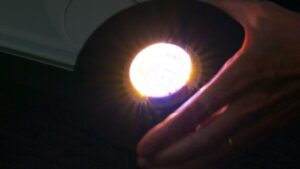A novel LED device that alternates between the sky’s red and blue hues witnessed at the beginning and end of a sunny day appears to advance natural melatonin levels faster than competing LED devices. According to the University of Washington (UW) researchers behind the novel device, their study may set a new benchmark in humans’ ability to directly influence their circadian rhythms, leading to better health outcomes for people facing out-of-sync circadian clocks.
For example, their approach may lead to effective treatments for people living in extreme latitudes who experience long periods of diminished sunlight and for people who work night shifts. Such a device could also offer a drug-free approach to counteract the effects of jet lag or even seasonal affective disorder (SAD), both of which can impact millions each year.
Natural Melatonin Production and Sleep
Scientists still don’t completely understand why humans need sleep, but they know the consequences of broken or inadequate sleep can be serious. In some cases, a severe lack of sleep can be deadly. In a press release announcing the new device, the researchers say they were motivated to explore the power of light to affect circadian rhythms by the significant number of health problems associated with an out-of-sync circadian clock.
When circadian rhythms operate naturally, the body synchronizes its wake/sleep cycle by taking cues from the rising and setting sun. This increases melatonin production in the evening, which causes sleepiness after the sun sets. This process has likely evolved over hundreds of thousands of years, making it vital to maintaining overall health.
“Our internal clock tells us how our body’s supposed to act during different times of day,” said Jay Neitz, a professor of ophthalmology at the UW School of Medicine and a co-author of the paper outlining the team’s work. “But the clock has to be set, and if our brain is not synced to the time of day, then it’s not going to work right.”
However, modern humans have access to artificial forms of light that many scientists believe disrupt this natural cycle by disrupting the natural melatonin production cycle. Combined with traditional factors that can affect the natural melatonin production cycle, like the changing seasonal sunlight and night work, a large portion of society is now suffering from broken or inadequate sleep patterns and the health problems that can be caused by artificial light sources all around us.
While melatonin supplements have offered mixed results, the medical community has responded with customized LED lights that are designed to help “reset” the body’s circadian clock and restore healthy sleep. The Debrief previously reported on the potential benefits of one of these blue lights, which its inventors claim could promote sleepiness and wakefulness on demand.
Still, reports suggest that the results of these devices have left some users wanting. Neitz believes this is because those devices only try to take advantage of the blue spectrum since it has been shown to affect the production of melanopsin. A photopigment that is found in the human eye, melanopsin communicates to the brain when experiencing blue light, something scientists believe directly affects melatonin production. The UW team’s device takes an entirely different approach.
Sleep-Inducing LED Alternates from Blue to Red
“The light we developed does not involve the melanopsin photopigment,” Neitz explained. “It has alternating blue and orange wavelengths that stimulate a blue-yellow opponent circuit that operates through the cone photoreceptors in the retina.”
According to Neitz, this opponent circuit is significantly more sensitive than melanopsin, “and it is what our brains use to reset our internal clocks.”


To determine which type of light source was most effective at advancing melatonin production, the study’s lead author, James Kuchenbecker, a research assistant professor of ophthalmology at the UW School of Medicine, decided to test three distinct LED lights.
The first device was a 500-lux white light. According to the researchers, this brightness level is “appropriate” for most office spaces. The second device was a short-wave blue LED light specifically designed to trigger the production of melanopsin. As noted, these lights are currently marketed as circadian rhythm support devices. The third and final device the team tested is their creation: an LED that alternates between red and blue hues 19 times per second. Because this rate is too fast for the human eye to perceive, the result is what the researchers describe as a “soft white glow.”
After selecting their lights, the team enlisted six study volunteers. Each volunteer tested each type of light for three days, with enough time between the tests to allow the volunteers to return to their baseline phases before testing the next light.
On the first day, volunteers were directed to collect saliva samples every hour from early evening until 2 a.m. These samples allowed the researchers to establish the baseline onset and peak of each study participant’s melatonin production.
After establishing the onset of each participant’s melatonin cycle, the researchers directed them to expose themselves to two hours of light from their selected device the following day. The time for each participant’s light cycle was selected based on their onset time, meaning each one was slightly different. During this phase, the participants were also directed to control their exposure to other light sources.
Alternating LED Showed Greatest Benefit for Melatonin Production
After collecting and analyzing the test data, the researchers found that the three LED light sources had a wide range of effects on melatonin production.
As expected, the generic 500-lux white light only advanced each participant’s melatonin production phase by 2.8 minutes. The blue light specifically designed to advance this cycle through melanopsin stimulation was more effective, resulting in a phase advance of 40 minutes. However, the researchers found that their device was the most effective by a significant amount.
“In terms of shifting the melatonin-production phase, the alternating blue-orange LED device worked best, with a phase advance of 1 hour, 20 minutes,” the press release explains. The researchers suspect this is due to their customized LED light mimicking the blue and red hues associated with the rising and setting sun.
“Even though our light looks like white to the naked eye, we think your brain recognizes the alternating blue and orange wavelengths as the colors in the sky,” Neitz explained. “The circuit that produced the biggest shift in melatonin wants to see orange and blue.”
The study “Toward an Indoor Lighting Solution for Social Jet Lag” was published in the Journal of Biological Rhythms.
Christopher Plain is a Science Fiction and Fantasy novelist and Head Science Writer at The Debrief. Follow and connect with him on X, learn about his books at plainfiction.com, or email him directly at christopher@thedebrief.org.

